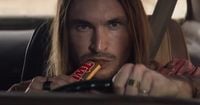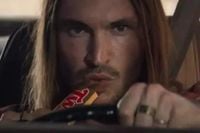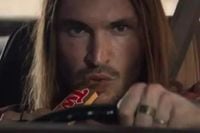The Advertising Standards Authority (ASA) has banned a recent Twix chocolate bar advert for encouraging unsafe driving, sparking a debate about the boundaries of creativity and responsibility in advertising. The ad, titled "Two Is More Than One," aired on television and video-on-demand platforms in March 2025 and quickly drew criticism from viewers who felt it glamorized dangerous driving behaviour.
The advert features a man with long, flowing hair driving a caramel-coloured retro-style car, pursued by an identical vehicle in what appears to be a high-speed chase. As the chase intensifies, the driver suddenly applies the handbrake, swerves sharply to the right, and crashes through a metal barrier, sending the car tumbling down a rocky hill. The climax reveals a surreal scene where the overturned car lands upside down on top of the identical car below, resembling the iconic Twix bar’s twin-stick design. The scene closes with a Twix bar falling through the sunroofs of both cars as they drive off still attached, accompanied by the tagline "two is more than one."
Despite the advert's playful and fantastical tone, five complaints were lodged with the ASA, accusing the commercial of promoting irresponsible and dangerous driving. The complainants argued that the depiction of reckless manoeuvres and a high-speed chase could encourage viewers to imitate such behaviour on public roads.
Mars Wrigley Confectionery, the owner of Twix, defended the advert by stating it was a "cinematic presentation" set in a "world that was absurd, fantastical and removed from reality." They emphasized that the driving scenes were carefully crafted, with the cars filmed at lawful speeds and without real-world identifiers such as pedestrians, other vehicles, or road signs to distance the setting from reality. The company also highlighted that the stunt sequences, particularly the dual car landing that defied physics, were exaggerated and impossible to replicate in real life.
Clearcast, the non-governmental organisation responsible for approving adverts before broadcast, supported Mars Wrigley’s position. They asserted that the advert’s style made it clear to viewers that the driving behaviour was not intended to be emulated and that it did not suggest safe driving was boring.
However, the ASA took a different stance. While acknowledging the fantastical elements and cinematic style, the watchdog pointed out that the first half of the advert depicted driving likely to breach the legal requirements of the Highway Code. It noted an "emphasis on speed," fast-paced music accompanying the chase, and visible skid marks on the road, all of which contributed to a portrayal of dangerous driving. The ASA concluded that the driving manoeuvres featured would be "dangerous and irresponsible if emulated in real life on a public highway." Consequently, the ASA ruled that the advert "must not appear again in its current form" and instructed Mars Wrigley Confectionery UK Ltd not to condone or encourage irresponsible driving in their advertising.
A spokesperson for Mars Wrigley responded to the ruling by reiterating the company’s commitment to high standards in all communications. They stated, "In our view, this particular advert adopts a fantastical tone that is neither realistic nor intended to be imitated. Nonetheless, we take our responsibility as an advertiser seriously and never intended to cause any offence or concern, so we are reviewing the ruling carefully in order to work collaboratively towards a resolution."
The decision has sparked discussion among advertising and legal experts. Geraint Lloyd-Taylor, partner and co-head of advertising and marketing at law firm Lewis Silkin, remarked on the occasional disagreements between Clearcast and the ASA, noting that advertisers take risks when depicting driving inconsistent with the Highway Code, even in fantastical settings. He commented, "I would say on balance it is hardly likely to inspire motorists on British roads to emulate what is shown." He described the ASA’s ruling as "overzealous," siding more with Clearcast's interpretation that the advert’s cinematic and absurd nature reduces the risk of real-life imitation.
Twix, known for its playful branding and absurd humour, has a long history dating back to its first production in the UK in 1967. It was introduced to the United States in the late 1970s and was originally branded as Raider in mainland Europe before unifying under the Twix name in 1991. The chocolate bar’s name, short for "twin sticks," is cleverly reflected in the advert’s imagery of two cars stacked like the iconic treat.
This incident highlights the delicate balance advertisers must strike between creativity and social responsibility, especially when depicting behaviours that could have real-world consequences. While fantastical and humorous elements are often employed to engage audiences, regulators like the ASA remain vigilant to ensure that such portrayals do not inadvertently encourage hazardous conduct.
The ASA's ruling serves as a reminder to advertisers that even when content is designed to be surreal or exaggerated, the depiction of potentially dangerous actions—such as reckless driving—must be handled with care to avoid sending the wrong message to viewers. Mars Wrigley’s ongoing review of the ruling suggests the company is keen to find a way to maintain its creative vision while adhering to regulatory standards.



